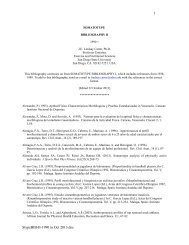THE HEATH-CARTER ANTHROPOMETRIC ... - Somatotype.org
THE HEATH-CARTER ANTHROPOMETRIC ... - Somatotype.org
THE HEATH-CARTER ANTHROPOMETRIC ... - Somatotype.org
You also want an ePaper? Increase the reach of your titles
YUMPU automatically turns print PDFs into web optimized ePapers that Google loves.
<strong>Somatotype</strong> Instruction Manual 4<br />
Upper arm girth, elbow flexed and tensed, right. The subject flexes the shoulder to 90 degrees<br />
and the elbow to 45 degrees, clenches the hand, and maximally contracts the elbow flexors and<br />
extensors. Take the measurement at the greatest girth of the arm.<br />
Calf girth, right. The subject stands with feet slightly apart. Place the tape around the calf and<br />
measure the maximum circumference.<br />
Read stature and girths to the nearest mm, biepicondylar diameters to the nearest 0.5 mm, and<br />
skinfolds to the nearest 0.1 mm (Harpenden caliper) or 0.5 mm on other calipers.<br />
Traditionally, for the anthropometric somatotype, the larger of the right and left breadths and<br />
girths have been used. When possible this should be done for individual assessment. However, in large<br />
surveys it is recommended that all measures (including skinfolds) be taken on the right side. The<br />
anthropometrist should mark the sites and repeat the complete sequence a second time. For further<br />
calculations, the duplicated measurements should be averaged. For more reliable values, relatively<br />
inexperienced measurers should take triplicate measurements and use the median value.<br />
Reliability of measurements<br />
The advantages of anthropometry are lost unless the measurements are accurate and reliable<br />
(i.e. precise). It is essential to learn precise measurement techniques and accurate calculations. Although<br />
at first sight anthropometry appears easy to the beginning investigator, obtaining a high level of skill and<br />
reliability requires training under a criterion anthropometrist and considerable practice.<br />
Although calculation of the Heath-Carter anthropometric somatotype is an objective procedure,<br />
the validity of the rating depends on the reliability of the measurements used. Investigators should report<br />
test-retest reliability of the measurements. In comparisons of distributions of two independent measures<br />
on the same subjects, the means should not differ significantly, and the Pearson product-moment r<br />
should be above 0.90. Specifically, height and weight should have test-retest values of r = 0.98. Girths<br />
and diameters should have r's between 0.92 and 0.98. For skinfolds r's between 0.90 and 0.98 are<br />
reasonable. Currently, many anthropometrists use the technical error of measurement (TEM) for<br />
evaluating the consistency, or precision, of the measurer on a given variable. The TEM is the square<br />
root of the sum of the differences between measures one and two squared, divided by twice the number<br />
of subjects (Cameron, 1984, Norton and Olds, 1996). The TEM provides an estimate of the<br />
measurement error that is in the units of measurement of the variable. This value indicates that two thirds<br />
of the time a measurement should come within +/- of the TEM. The TEM can be converted to a<br />
percentage of the mean of the total number of measures (grand mean). This allows for comparisons<br />
among measures or for groups of variables. Generally, the TEM for skinfolds should be about 5%, and<br />
that for breadths and girths 1%, and for height about 0.5% The equations are as follows:<br />
TEM = (<br />
d 2 / 2n) 0.5 ; and %TEM = 100 (TEM/grand mean)<br />
Calculating the Anthropometric <strong>Somatotype</strong><br />
There are two ways to calculate the anthropometric somatotype.<br />
(A) Enter the data onto a somatotype rating form.<br />
(B) Enter the data into equations derived from the rating form.<br />
The use of the rating form will be described first. Figures 1 and 2 are examples of calculations<br />
using the rating form. It is assumed that the measurements have been recorded on an appropriate<br />
3/19/2003




